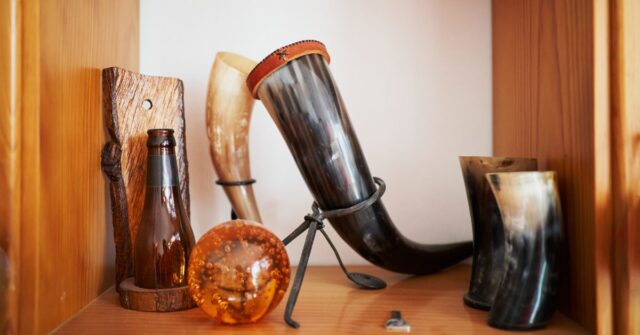Welcome to your comprehensive guide on acquiring a quality drinking horn without breaking the bank.
Whether you’re a history enthusiast, a participant in medieval reenactments, or simply looking for a unique piece to add to your collection, this guide is designed to walk you through the essentials of selecting, buying, and maintaining a drinking horn.
Introduction to Drinking Horns
Drinking horns have been vessels of choice in many cultures throughout history, from the Vikings of Scandinavia to the tribes of Africa.
Their appeal lies not only in their historical significance but also in their unique charm and craftsmanship.
History and Cultural Significance
Historically, drinking horns were more than just drinking vessels; they were symbols of status and power.
The larger and more ornate the horn, the higher the owner’s status. Today, they evoke images of medieval banquets and heroic feats, enriching their allure to collectors and enthusiasts.

Modern Uses and Popularity
In modern times, drinking horns have seen a resurgence in popularity, especially within groups fond of historical reenactments and fantasy literature.
They are also popular at festivals, weddings, and themed events, where they add a touch of historical authenticity and fun.
Understanding the Basics of Drinking Horns
Before diving into your purchase, it’s crucial to grasp the basics of what makes a good drinking horn.
What is a Drinking Horn?
A drinking horn is typically made from the horn of a bovine, though other animals such as buffalo and rams are also used. Each horn is hollowed out, cleaned, and polished to serve as a drinking vessel.
Types of Drinking Horns
Drinking horns can range from simple, unadorned pieces to elaborate works of art featuring metalwork and engraving. They may also come with stands or leather holders to improve functionality.
Materials Used in Making Drinking Horns
The quality of the material directly affects the horn’s longevity and safety for drinking. Horns from healthy animals with thick and robust keratin are preferred for their durability and aesthetic appeal.
Factors to Consider When Choosing a Drinking Horn
Selecting the right drinking horn involves careful consideration of several factors to ensure you get the best value for your money.

Size and Capacity
Drinking horns come in various sizes, from small drinking cups to large blow horns. Consider the intended use—whether it’s for display or for drinking—to determine the appropriate size.
Material Quality and Source
The source of the horn is vital. Ethically sourced horns from domestic animals are the most common. Ensure the horn is free of cracks and holes that could affect its usability.
Workmanship and Authenticity
The craftsmanship can significantly impact the price. Handcrafted horns, though potentially pricier, are typically of higher quality than mass-produced ones.
Look for horns made by skilled artisans for the best quality.
Functional vs. Decorative
Decide if your horn will be used for drinking or purely for decoration. Functional horns require food-safe sealing and regular maintenance, while decorative horns might focus more on aesthetics.
Where to Buy Budget-Friendly Drinking Horns
There are several places to find drinking horns without overspending.
Online Retailers and Marketplaces
Online stores often offer a wide range of options at competitive prices. Look for sellers with good reviews and clear product descriptions to avoid disappointment.
Specialty Stores and Craft Markets
Local craft markets and specialty stores can be great sources for finding handcrafted horns. Plus, buying locally supports artisans directly.

Medieval Fairs and Historical Reenactments
These events often feature vendors who specialize in historical items like drinking horns. It’s an opportunity to see and feel the horns firsthand, and to negotiate prices directly with the craftspeople.
How to Assess Quality and Authenticity
Knowing how to evaluate the quality and authenticity of a drinking horn is crucial, especially if you’re looking for a functional piece.
Visual Inspection Tips
Look for a smooth interior and a polished exterior. Any smell of decay or mold is a red flag. The edges should be smooth and free of chips.
Questions to Ask the Seller
Don’t hesitate to ask the seller about the source of the horn and the process used in its making. This can help you assess the ethical and quality aspects of the horn.
Understanding Pricing
Prices for drinking horns can vary widely. Factors influencing the price include the size, material, craftsmanship, and any historical significance.
Set a budget beforehand, but be prepared to adjust if you find a piece that truly stands out.
Maintaining Your Drinking Horn
Maintaining your drinking horn is essential to preserve its quality and ensure it remains safe to use.

Cleaning and Care
Never use a dishwasher. Wash by hand with mild soap and warm water and dry thoroughly. Avoid harsh chemicals that could damage the horn.
Storage Tips
Store your horn in a cool, dry place out of direct sunlight. If it has a metal rim or decorations, consider occasional polishing to prevent tarnish.
DIY Drinking Horns: A Smaller Budget Alternative
If you’re crafty, making your own drinking horn can be a rewarding project.
Materials Needed
You’ll need a raw horn, sandpaper, a sealant appropriate for food contact, and basic tools like a saw and a drill.
Step-by-Step Guide to Making Your Own
Begin by cutting the horn to size, then sanding down the rough edges. Clean it thoroughly inside and out before applying a food-safe sealant. Allow it to cure as directed before use.
Check out this article for an in-depth guide.
Conclusion
We hope this guide helps you find a drinking horn that meets both your aesthetic and budgetary needs.
Remember, a good drinking horn is not just a drinking vessel; it’s a piece of history that brings with it stories of feasts and valor.
Enjoy the journey of finding your perfect horn, and may it serve you well at many gatherings to come!











